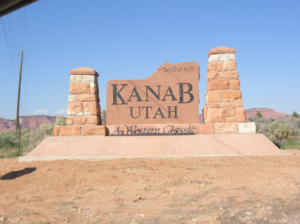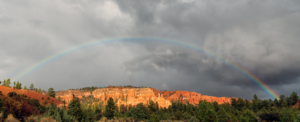It’s a story shrouded in mystery, dating back 500 years, and puzzling people to this day. A possible treasure buried around Kanab, Utah, has its origins from when Spaniard Hernán Cortés landed in Mexico in 1509. Here’s what you need to know about the hunt.
It’s a story shrouded in mystery, dating back 500 years, and puzzling people to this day. A possible treasure buried around Kanab, Utah, has its origins from when Spaniard Hernán Cortés landed in Mexico in 1509. Upon the Spanish conquistadors’ arrival, the Aztec Emperor Montezuma offered Cortés gifts to ease potential disputes. This generosity, some believe, sparked Cortés’ thirst for riches. He put the emperor on house arrest and pillaged the town of Tenochtitlán for gold and silver, torturing and killing many of the native people.
The Aztecs rebelled against the Spaniards, and Cortés brought Montezuma out of the palace to appease them. But when the Aztecs saw their emperor’s new ties with the Spaniards, they felt betrayed and attacked him with stones and spears. Montezuma died, and Cortés and his men were forced to flee.
Legend has it that thousands of Aztec men—both warriors and slaves—headed north to seek a resting place for the remaining riches. After they buried the cache in the desert, the warriors sacrificed their slaves to watch over it for eternity. Cortés and his men scoured the region, but the treasure of Montezuma was—and remains—nowhere to be found.
A Town Frenzy: Treasure in Kanab?
In the early 1900s, Kanab, Utah, was a small farming community set in the red rock desert of Southwest Utah. In 1912, the town made a bit of history for having the first all-women city council and mayor. Two years later, as the city council was serving its final, productive year in office, a prospector named Freddy Crystal arrived in town with high hopes. He brought with him a map with illustrations of Aztec petroglyphs.
Freddy had been in Mexico when he came across a monastery set for demolition. As he leafed through old manuscripts from the time of Hernán Cortés, Freddy discovered a hand-drawn map that he claimed bore a striking resemblance to the terrain around Kanab. He set off on a hunt to find a cave with the Aztec petroglyphs at the entrance. It was here, he thought, that Montezuma’s treasure was buried.
It wasn’t until 1922 that Freddy Crystal discovered the cave that fit the bill. According to local legend, Freddy and his men stood atop a canyon rim after years of fruitless searching. He gazed out across the desert landscape and then looked back at his map. Suddenly, it hit him: the cave in front of him matched the one on his map. He ran down to the entrance, which towered high above him. Stairs carved into sandstone led to the base of the cave, which was sealed up with stone mortar. Freddy and his group scraped away at the wall with pocket knives. When that didn’t do the job, he brought the news back to the townspeople in Kanab. Excitement and anticipation buzzed throughout the town, as everyone wanted part of the treasure
The town of Kanab all but shut down as nearly three-quarters of its residents flocked to the hills to unearth the treasure site. They worked tirelessly, digging out the labyrinth of sand-filled tunnels. However, after months without a sign of Montezuma’s treasure, the workers finally gave up and headed back home with their heads hung. Eventually, Freddy Crystal left, never to be seen in town again.
The Hunt Continues

J. Stephen Conn
While the treasure is said to be cursed—and frankly, which treasure isn’t?—that hasn’t stopped others from working to unlock the mystery. Since the days of Freddy Crystal and his map, numerous adventurers have set out to find the treasure for themselves.
High above the sagebrush-filled wash sits Freddy’s cave, worn deep in the white cliffs of sandstone. Explorers have long since navigated this cave in Johnson Canyon, searching for clues. Although Freddy and his men never found the treasure, they discovered an extensive tunnel system. Many artifacts and bones were unearthed amidst a maze of booby traps—holes that dropped deep into the ground.
When seekers failed to find treasure in the Johnson Canyon tunnels, locals speculated about other hiding places. The hunt continues to this day, as treasure seekers believe it could be hidden in a pit below the Three Lakes pond north of town. Brandt Child, a Kanab resident, thinks the treasure lies in a water trap almost 40 feet below the water’s surface. He bought the property in 1989 to investigate. Divers attempted to search the pond but returned with nothing but chilling tales. First, their air compressors malfunctioned. Then, as divers approached the underwater tunnel, they encountered shadowy figures and experienced a choking sensation. Unable to breathe, they shouted at Child to pull them out.
Child then decided to drain the lake but encountered yet another unexpected roadblock. This pond is the only known habitat of the Kanab ambersnail, an endangered species. Killing this snail results in a $50,000 fine. So the treasure remained guarded, this time by the U.S. Fish and Wildlife Service.
Since then, many who have attempted to find the treasure have met untimely deaths. Brandt Child perished after hitting a horse with his car. Another prospector drilled toward the tunnel and brought up gold on the drill bit. When he drilled again, the drill bit broke off, postponing the search. Later that night, the man died from a heart attack before he could make any progress. In an atmosphere of infectious obsession, many believers attribute these deaths to the treasure’s curse.
Today, the Best Friends Animal Sanctuary, a no-kill sanctuary for homeless pets, owns the Three Lakes property. No plans exist to continue the hunt for the treasure, and the lake sits, along US 89, untouched.
Celebrating the Legend: The Annual Kanab Treasure Quest

John Fowler
Kanab residents embraced their role in this enchanting narrative: Every year, a one-of-a-kind treasure hunt occurs over the first weekend in November. Kanab’s Treasure Quest offers participants the opportunity to complete challenges and earn points through a phone app. These challenges include trivia, puzzles, and tasks—think a treasure hunt mixed with The Amazing Race and you’ll have some idea of the fun that will ensue. The top 10 players compete in a sudden death round for the Grand Prize.
The competition allows residents and visitors the chance to win up to $10,000 in cash and prizes. It is not quite Montezuma’s treasure, but these rewards come with their own bragging rights (and no curse). This treasure quest is an excellent way to get to know the Kanab region through family-friendly activities.
Finding the Treasure in the End
Montezuma’s treasure may have drawn many adventurers to the desert surrounding Kanab over the last century, but the real reward is the endless natural beauty of its striated sandstone, towering plateaus, and juniper-dotted hills. Kanab, nestled amongst miles of unspoiled wilderness, provides access to three national parks, five national monuments, and two state parks. Just as in the time of Montezuma’s treasure, Kanab is the perfect base camp for adventure. Unlimited hiking opportunities are complemented by a thriving local food and arts scene. Be careful: once you experience Kanab, you may never want to leave.
Written by Hannah Singleton for Matcha in partnership with Kane County.